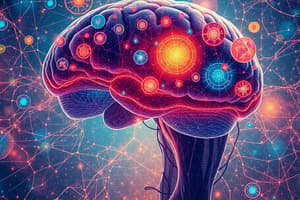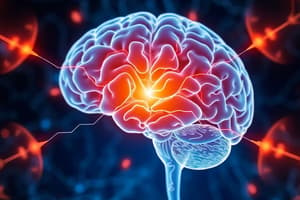Podcast
Questions and Answers
What type of amnesia is characterized by the inability to form new memories after an event?
What type of amnesia is characterized by the inability to form new memories after an event?
- Dissociative amnesia
- Retrograde amnesia
- Hyperthymesia
- Anterograde amnesia (correct)
Which cortical area is associated with working memory?
Which cortical area is associated with working memory?
- Occipital lobe
- Temporal lobe
- Parietal lobe
- Frontal lobe (correct)
What does the Hebb rule state?
What does the Hebb rule state?
- Cells that rest together, thrive together.
- Cells that fire together, wire together. (correct)
- Cells that learn together, forget together.
- Cells that divide together, stay together.
What is neurogenesis?
What is neurogenesis?
What is the primary function of melatonin?
What is the primary function of melatonin?
Which of the following is a characteristic of working memory?
Which of the following is a characteristic of working memory?
Why do humans experience worse effects of jet lag when flying east compared to west?
Why do humans experience worse effects of jet lag when flying east compared to west?
What is long-term potentiation associated with?
What is long-term potentiation associated with?
What role does retinal disparity play in vision?
What role does retinal disparity play in vision?
Which theory of color perception suggests that colors are perceived through three types of cones?
Which theory of color perception suggests that colors are perceived through three types of cones?
What are on-center and off-center ganglion cells primarily involved in?
What are on-center and off-center ganglion cells primarily involved in?
What is the function of muscle spindles?
What is the function of muscle spindles?
What is a characteristic behavior of the opponent process theory?
What is a characteristic behavior of the opponent process theory?
Which of these is NOT a type of receptor for skin senses?
Which of these is NOT a type of receptor for skin senses?
What phenomenon is associated with lateral inhibition in visual processing?
What phenomenon is associated with lateral inhibition in visual processing?
What is the primary function of the vestibular organs?
What is the primary function of the vestibular organs?
Which nucleus relays auditory inputs in the thalamus?
Which nucleus relays auditory inputs in the thalamus?
What are the two binaural cues that help locate sounds?
What are the two binaural cues that help locate sounds?
What is expressive aphasia?
What is expressive aphasia?
Which eye movement is characterized by the eyes tracking a moving object?
Which eye movement is characterized by the eyes tracking a moving object?
Which theory of sound perception focuses on the place along the cochlea that is stimulated?
Which theory of sound perception focuses on the place along the cochlea that is stimulated?
What is the role of the right cerebral hemisphere in language processing?
What is the role of the right cerebral hemisphere in language processing?
What are photopic and scotopic vision primarily related to?
What are photopic and scotopic vision primarily related to?
What is the adequate stimulus for the visual system?
What is the adequate stimulus for the visual system?
What are the two dimensions commonly associated with most dimensional models of emotion?
What are the two dimensions commonly associated with most dimensional models of emotion?
Which study supports the James-Lange theory of emotion?
Which study supports the James-Lange theory of emotion?
What is the primary role of the amygdala in emotional processing?
What is the primary role of the amygdala in emotional processing?
How does brief stress affect the body's systems according to the General Adaptation Syndrome (GAS)?
How does brief stress affect the body's systems according to the General Adaptation Syndrome (GAS)?
What are the two types of thirst identified in physiological studies?
What are the two types of thirst identified in physiological studies?
What is the function of the hypothalamic-pituitary-adrenal (HPA) axis in stress response?
What is the function of the hypothalamic-pituitary-adrenal (HPA) axis in stress response?
Which theory explains the necessity of balancing arousal levels for optimal performance?
Which theory explains the necessity of balancing arousal levels for optimal performance?
What are the four basic forms of learning identified in psychological studies?
What are the four basic forms of learning identified in psychological studies?
Flashcards
Declarative Memory
Declarative Memory
Type of memory that involves conscious recollection of facts, events, and personal experiences.
Non-Declarative Memory
Non-Declarative Memory
Type of memory that involves unconscious learning and skill acquisition, not easily verbalized.
Classical Conditioning
Classical Conditioning
Type of learning where a neutral stimulus is paired with a meaningful stimulus, causing the neutral stimulus to elicit the same response.
Instrumental Conditioning
Instrumental Conditioning
Signup and view all the flashcards
Anterograde Amnesia
Anterograde Amnesia
Signup and view all the flashcards
Retrograde Amnesia
Retrograde Amnesia
Signup and view all the flashcards
Working Memory
Working Memory
Signup and view all the flashcards
Hebb Rule
Hebb Rule
Signup and view all the flashcards
Retinal Disparity
Retinal Disparity
Signup and view all the flashcards
Retinotopic Map
Retinotopic Map
Signup and view all the flashcards
Trichromatic Theory
Trichromatic Theory
Signup and view all the flashcards
Opponent Process Theory
Opponent Process Theory
Signup and view all the flashcards
Lateral Inhibition
Lateral Inhibition
Signup and view all the flashcards
On-Center and Off-Center Ganglion Cells
On-Center and Off-Center Ganglion Cells
Signup and view all the flashcards
Muscle Spindles
Muscle Spindles
Signup and view all the flashcards
Golgi Tendon Organs
Golgi Tendon Organs
Signup and view all the flashcards
Thalamus Subdivisions
Thalamus Subdivisions
Signup and view all the flashcards
Dorsal and Ventral Streams
Dorsal and Ventral Streams
Signup and view all the flashcards
Frequency Theories of Sound Perception
Frequency Theories of Sound Perception
Signup and view all the flashcards
Binaural Cues for Sound Localization
Binaural Cues for Sound Localization
Signup and view all the flashcards
Broca's and Wernicke's Areas
Broca's and Wernicke's Areas
Signup and view all the flashcards
Angular Gyrus and Right Hemisphere in Language
Angular Gyrus and Right Hemisphere in Language
Signup and view all the flashcards
Aphasia and Dyslexia
Aphasia and Dyslexia
Signup and view all the flashcards
Second Language Processing
Second Language Processing
Signup and view all the flashcards
Dimensional vs. Discrete Emotion Models
Dimensional vs. Discrete Emotion Models
Signup and view all the flashcards
Schachter-Singer Theory
Schachter-Singer Theory
Signup and view all the flashcards
James-Lange Theory
James-Lange Theory
Signup and view all the flashcards
Amygdala's Role in Emotion
Amygdala's Role in Emotion
Signup and view all the flashcards
HPA Axis
HPA Axis
Signup and view all the flashcards
Allostasis vs. Homeostasis
Allostasis vs. Homeostasis
Signup and view all the flashcards
Yerkes-Dodson Law
Yerkes-Dodson Law
Signup and view all the flashcards
Types of Thirst
Types of Thirst
Signup and view all the flashcards
Study Notes
Sensory Information Pathways
- Subdivisions of the thalamus relay sensory information: lateral geniculate nucleus (visual), medial geniculate nucleus (auditory), and ventral posterior nucleus (somatosensory).
Auditory and Visual Processing
- Dorsal and ventral streams process auditory and visual information (Chapter 6, page 226).
- Dichotic listening paradigm presents different auditory information to each ear to study selective attention.
Theories of Sound Perception
- Frequency, place, frequency-volley-place theories explain sound perception (Chapter 7, page 255).
Binaural Cues for Sound Localization
- Inter-aural intensity and timing differences help locate sounds.
- Sound shadow effect is more apparent with higher-frequency sounds.
- Lateral and medial superior olives process sound localization.
- Coincidence detectors are used to locate sound.
Language Processing
- Broca's area, Wernicke's area, and the Wernicke-Geschwind model are important for language processing.
- Angular gyrus is involved in language processing.
- Expressive and receptive aphasia, dyslexia, and alexia are different types of language disorders.
Cognitive Processing of Multiple Languages
- Cognitive processing of a second language acquired later in life differs from first language acquisition.
- Lexical knowledge is stored in declarative memory, and grammatical knowledge is in implicit and declarative memory (L1 and L2 respectively).
Visual System
- Light is the adequate stimulus for the visual system.
- Colors have different wavelengths (shortest: purple, longest: red).
- Color perception involves hue, brightness, and saturation.
- Vergence, saccadic, and pursuit movements are different types of eye movements.
- Photopic and scotopic vision are related to photoreceptor distribution.
Visual Field and Receptive Field
- Visual field and receptive field are described and distinguished.
- Retinal disparity helps identify distance to objects.
Visual Information Processing
- Visual pathways and retinotopic maps are discussed.
- Color perception theories are described: trichromatic theory, opponent process theory, and Hurvich-Jameson theory.
- Common visual illusions (Hermann grid, Mach bands) are described.
- Spatial frequency theory is related to visual perception.
Skin Senses Receptors
- Skin senses have free nerve endings (for temperature and pain) and encapsulated receptors (for touch).
- Receptor types for touch include Meissner's corpuscles, Merkel's discs, Pacinian corpuscles, and Ruffini endings.
- Sensory sensitivity is correlated with receptor density.
Vestibular System
- Vestibular organs (semicircular canals, utricle, saccule) are part of the vestibular system, involved in balance and spatial orientation.
Muscle System
- Skeletal muscles, smooth muscles, and cardiac muscles are different types of muscles.
- Movements involve flexion, extension, and the functions of agonist and antagonist muscles (specific movements are mentioned).
- Muscle spindles and Golgi tendon organs are related to muscle action.
Body Senses Pathways
- Body senses pathways are described including organization of pathways.
Motor Areas
- Primary, premotor, and supplementary motor areas contribute to movement control.
- Basal ganglia and cerebellum are crucial for coordinated movement.
Emotion
- Different models of emotion are described including dimensional models and discrete emotion theory.
- Schacter-Singer, James-Lange, and Cannon-Bard theories of emotion are discussed including the related experiments that support them.
Emotional Processing Areas
- Functions of the septum, cingulate cortex, amygdala, and prefrontal area in emotional processing.
Stress Response
- Hypothalamic-pituitary-adrenal (HPA) axis is described as a stress response mechanism and how it differs in short-term and long-term stress.
- Instincts, drives, and arousal related to stress response
Thermoregulation
- Major thermoregulation centers location in the preoptic area in the hypothalamus, thirst, and the mechanisms of eating (fasting/absorptive).
Learning and Memory
- Learning and different learning models are described.
- Declarative vs. non-declarative memory.
- Classic and instrumental conditioning types are described.
- Memory related types of amnesia (H.M.) are described.
- Other related memory properties
Working Memory
- Details of working memory including components and cortical areas are included.
- The storage characteristics of working memory are described including its active and limited nature.
Long-Term Potentiation
- Neurochemical processes in long-term potentiation, including Hebb rule are described.
- Different concepts of neurons firing together to form long-term memories.
Circadian Rhythms and Sleep
- Suprachiasmatic nucleus (SCN) plays a major role in circadian rhythms.
- Effects of flying across time zones.
- Descriptions of stages and patterns of sleep are included.
- Sleep-wake cycle regulation concepts
Abnormal Behavior
- Different types of anxiety disorders are described, along with their descriptions and neural mechanisms associated.
- Common psychotic disorders are described, including schizophrenia and its symptoms and the related neural hypotheses.
- Affective disorders (mood disorders) are outlined including the major types, descriptions, and associated theories.
Studying That Suits You
Use AI to generate personalized quizzes and flashcards to suit your learning preferences.




